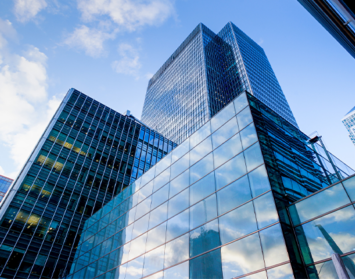For almost two years, there have been headlines in the financial press speculating of a “second shoe to drop” in the stock market. The writers note that hundreds of billions of dollars of commercial real estate loans will come due, speculating that this will trigger massive foreclosures, further crippling the banking system, and thus causing a “second shoe to drop” ruining the broader stock market. However, this hasn’t, and won’t come to pass.
The commercial real estate recession of the early ’90s was different than this one. If you have been around San Diego since 1990, you might recall that virtually every single Downtown and UTC high-rise building was foreclosed on from 1992 to 1995. Qualcomm bought The San Diego Design Center (now an engineering building) and other office buildings in Sorrento Mesa for $50 per-square-foot, and vacant lots in Poway Industrial Park were being sold to any buyer willing to take over the taxes and bond obligations. Land in Sorrento Mesa sold for $4 per-square-foot back in 1993. If you could buy it today, it would likely cost 10 times that. But why aren’t we seeing depressed values like this today?
First, the nature of property ownership is different this time. Back in the early ’90s, buildings were owned by individual real estate developers, where there was typically a separate equity partner and a construction lender. When the commercial real estate market became distressed due to overdevelopment and the general recession from 1991-1993, the developers didn’t have any money (which is why they had the equity partner to start with), and the equity partner didn’t want to throw good money after bad. The property’s ownership typically went back to the lender through foreclosure. This downward spiral was exacerbated by the Resolution Trust Company (RTC), which was the arm of the federal government that took over most of the savings and loan (S&L) industry, and the RTC dumped the commercial real estate assets and loans that the S&L’s had on their books as fast as possible.
Today, a high percentage of San Diego commercial real estate is owned by deep pocketed institutional owners, who own massive and diversified portfolios of commercial real estate. As a lesson of the early ’90s, investors didn’t want to own just one building anymore, so Real Estate Investment Trusts (REIT’s) became a vehicle by which properties could be pooled, and investors would buy into the pool of assets versus buying a single property. Examples of public company REIT’s owning assets in San Diego include Kilroy Realty with 5.1 million squafe feet; Alexandria Real Estate with 2.1 million square feet; Biomed Realty Trust with 1.3 million square feet; and Arden Realty with 2.3 million square feet (formerly a public REIT, now a subsidiary of GE). Additionally, public pension funds and other investment funds have bought into the commercial real estate market over the last 15 years. Examples include RREEF with 3 million square feet, and TIAA CREF with 1.3 million square feet. Sophisticated investment managers raised money to purchase properties on behalf of investors in diversified partnerships, like LBA Realty, which owns 2.2 million square feet, and TA Associates at 2.9 million square feet. Over the last three decades, long-standing private money has gobbled up San Diego investments, or built in the region at a very conservative pace, like The Irvine Co. at 7.3 million square feet; H.G. Fenton at 3.5 million square feet and Collins Development Co. at 3.2 million square feet. These institutional investors are committed to weathering this real estate recession’s storm, and in many cases are prepared to buy more assets as they come to market, as Kilroy, Alexandria and Biomed are already doing this year.
Second, the nature of the debt is different this time. Most of these owners have very low debt ratios, versus the go-go early ’90s where developers would often fund their projects with 90 percent to 100 percent financing. The easy availability of money in the early ’90s was part of the reason commercial real estate became so overbuilt. This time around, investors overpaid at the bubble 3-4 years ago, but most didn’t overfinance. As a savior to investors this time around, interest rates have come down from 3-4 years ago, so the debt service has come down.
Much has been written recently about the hundreds of billions of dollars of commercial real estate debt that is coming due in the next two years. But just because debt comes due, doesn’t mean the debt is bad. In fact, much of the debt that has come due is performing. Other debt that isn’t performing is being discounted by the lender, or the existing owner is bringing in financial partners to put new money into the property to buy down the debt so it does perform.
Our industry is calling this the “extend and pretend” approach, but stabilizing these properties so the owner can stand to fight another day is crucial to the stability of the financial sector. Fundamentally, lenders don’t want to foreclose on the commercial real estate assets, as then the lender has to reserve cash against the foreclosed property. Worse yet, the lender then has to operate the property, lease it, and try to sell it at distressed prices.
Third, the nature of the commercial real estate asset class is different this time. Back in the early ’90s, virtually no one wanted to touch commercial real estate investment. However, a few gutsy real estate investors bought cheap and later sold high, and became very rich in that cycle. This current decade’s generation of commercial real estate investors were not about to miss out on the next California property rush. Thus, billions of dollars of investment capital were raised in 2008 and 2009 waiting for the market collapse…that has yet to come. There aren’t any willing sellers out there, and when a building does come available for sale, it generally is less than 40,000 square feet and filled with deferred maintenance —not what institutional owners are interested in, as the size is too small and quality generally too low. While this is a big disappointment to would-be commercial real estate investors, we can all sleep better at night knowing that the commercial real estate sector is not going to trigger a second shoe to drop.
David Marino is senior executive vice president of Hughes Marino, a global corporate real estate advisory firm that specializes in representing tenants and buyers. Contact David at 1-844-662-6635 or david@hughesmarino.com to learn more.









